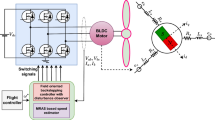Abstract
In this study, a new sliding mode control with varying boundary layers is proposed to improve the tracking performance of a nonlinear electro-hydraulic position servo system, which can be found in many manufacturing devices. The key feature of the proposed control scheme is the use of varying boundary layers instead of fixed boundary layers, which are usually employed in conventional sliding mode control. The validity of the proposed control scheme is verified through practical testing on an experimental electro-hydraulic positioning device. In the cases of step and sinusoidal command inputs, the experimental results strongly suggest that the proposed control scheme is capable of improving the tracking precision without causing any chattering. In addition, the new control scheme seems to be very robust against various set point conditions .
Similar content being viewed by others
References
Fung RF, Wang YC, Huang HH (1997) A variable structure control with proportional and integral compensations for electro-hydraulic position servo control system. Mechatron 7:67–81
Merrit HE (1967) Hydraulic control system. Wiley, New York
Renn JC (1997) A new approach to synthesize the feedback gain of state-space controller for a servo hydraulic position system. J Control Syst Technol 5:51–59
Chen HM, Su JP, Renn JC (2002) A novel sliding mode control of an electro-hydraulic position servo system. IEICE Trans Fundam Electron 85(8):1928–1936
Ha QP, Nquygn HQ, Rye DC, Durrant-Whyte HF (1998) Sliding mode control with fuzzy tuning for an electro-hydraulic position servo system. Proceedings of the IEEE Conference on Knowledge-Base Intelligent Electronic System, Adelaide, Australia, 1998,pp 141–148
Slotine JJE (1984) Sliding controller design for non-linear systems. Int J Control 40:421–434
Hung JY, Gao W, Hung JC (1993) Variable structure control: a survey. IEEE Trans Ind Electron 40:2–2
Su JP (2001) Robust control of a class of nonlinear cascade systems: a novel sliding mode approach. Proc IEE Control Theory Appl 149(2):131–136
Utkin VJ (1997) Variable structure systems: a survey. IEEE Trans Automat Contr 22:212–222
Chern TL, Wu YC (1991) Design of integral variable structure controller and application to electro hydraulic velocity servo systems. IEEE Proc D 138:439–444
Fung RF, Yang RT (1998) Application of VSC in position control of a nonlinear electro hydraulic servo system. Comput Struct 66(4):365–372
Hwang CL (1996) Sliding mode control using time-varying switching gain and boundary layer for electrohydraulic position and differential pressure control. Proc IEE Control Theory Appl 143:325–33
Slotine JJE, Li W (1991) Applied nonlinear control. Prentice-Hall, Englewood Cliffs, NJ
Author information
Authors and Affiliations
Corresponding author
Rights and permissions
About this article
Cite this article
Chen, HM., Renn, JC. & Su, JP. Sliding mode control with varying boundary layers for an electro-hydraulic position servo system. Int J Adv Manuf Technol 26, 117–123 (2005). https://doi.org/10.1007/s00170-004-2145-0
Received:
Accepted:
Published:
Issue Date:
DOI: https://doi.org/10.1007/s00170-004-2145-0




